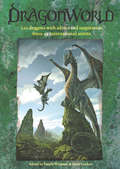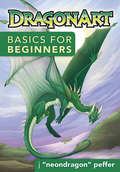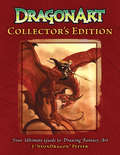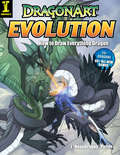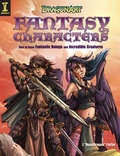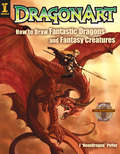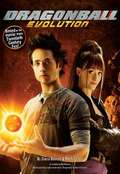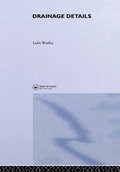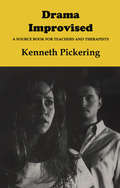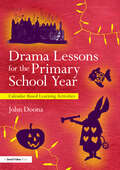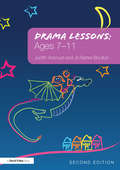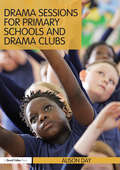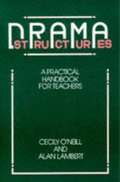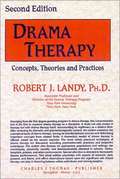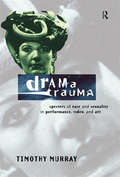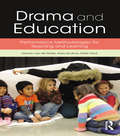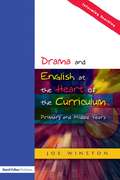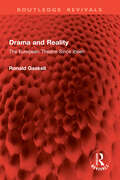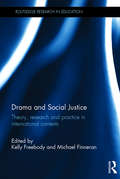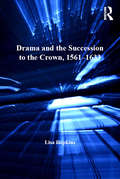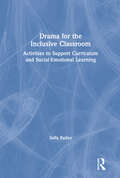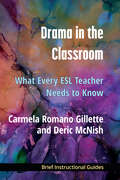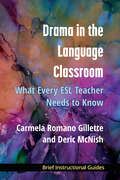- Table View
- List View
Dragon World: Amazing dragons, advice and inspiration from the artists of deviantART
by Pamela Wissman Sarah LaichasFrom fire-breathing to friendly, dragons pretty much rule the fantasy world. Dedicated to the coolest of mythological beasts, DragonWorld is a showcase of some of today's best, most imaginative dragon art. Some stick to the popular notion of what a dragon is, while others offer more unexpected interpretations. Behind this fiercely creative work is a diverse group of young international artists who have developed loyal fan followings on the popular online showcase, deviantART.com. Look inside to see why. 120 creations from 49 cutting-edge dragon artists all on deviantART.com •Represents a wide variety of mediums—both traditional and digital—and an even wider variety of stylistic interpretations from classic to futuristic •Q&A-style profiles offer fascinating insights on the artists' techniques and inspirations
DragonArt Basics for Beginners
by J Neondragon" PefferDragons are terrifying creatures, and do not like to be drawn by just anyone! If you're brave enough to take on the task, you'll appreciate the lessons in this book for guiding you on your treacherous journey! By the end, you'll have created some great scaly friends.
DragonArt Collector's Edition: Your Ultimate Guide to Drawing Fantasy
by J. Neondragon" PefferMake your fantasy world a reality. Conjure up the mythical heroes and fantastical beasts that roam your imagination. With just a pencil, some paper - and perhaps a broadsword - you can unleash the mighty monsters of your mind, including deadly dragons and brutish orcs, or ethereal inhabitants such as elegant elves and mermaids. Artist and dragon expert J "NeonDragon" Peffer (along with Dolosus, her fire-breathing dragon familiar) will give you tips and tricks to help you create your own unique fantasy world full of legends, fairy tales and things that go bump in the night. Surpass the drawing skills of mere mortals with this master collection of easy-to-follow, step-by-step instruction. Learn to build even the most elaborate characters through simple color-coded diagrams demonstrating how to use basic shapes, three-dimensional shading and a variety of color schemes. Create complete scenes, and enhance your creations by learning how to draw believable backgrounds. Discover how to relay facial expression and personality. Accessorize your mythical minions with a variety of unique details such as beards, wings, fins, hooves, fangs and tusks. Dress your Victorian vampires and noble centaurs in fantasy fashions to make them warriors, rangers, clerics, peasants, or any role you can imagine. In fantasy, there are no rules, and anything is possible. The more you draw, the better you'll get. It's your world: Now go create it.
DragonArt Evolution: How to Draw Everything Dragon
by J. Neon PefferA dragon artist's guide to better drawing Magnificent and powerful creatures, these dragons be, with bone-crushing jaws and razor-sharp teeth, it's difficult to tell whether you're dealing with a hotheaded nature or a wise and benevolent beast. Therein lies the trouble with drawing them from life. Make your dragon portraits more authentic (while avoiding loss of life and limbs) with the help of this guide. A follow-up to the fiercely popular DragonArt, this book features ALL NEW dragons and EVEN MORE detailed dragon anatomy instruction. 60+ step-by-step demonstrations cover a variety of dragons, including medieval, fairy and sea-dwelling varieties In-depth advice for drawing every part of the beast-eyes, ears, horns, wings, scale patterns, limbs and more Extra tips and tricks provided by your dragon guide, Dolosus It's everything you need to draw a variety of dragons-from enormous, ancient beasts with broken scales and fractured horns, to sleek, sinuous creatures with leathery skin and fancy frills. So steel your heart, prepare your trusty inking pen, and venture forth, brave artist-unleash the ferocious, extraordinary, original beasts that dwell within your fiery imaginings!
Dragonart Fantasy Characters: How to Draw Fantastic Beings and Incredible Creatures
by J Neondragon" PefferGive life to the beings that roam your imagination! Dragons may terrorize fantasy worlds, but they need peasants to munch on . . . heroes to confront . . . elegant elves, shrewd sorcerers and dreaded demons to battle. Following on the wings of the ferociously popularDragonArt, this book shows you how to conjure up your own fantasy realms by drawing inspiration from fairy tales, legends and (if you dare) things that go bump in the night. Breathe the life into your beings by basing them upon fundamental human anatomy#151;proportions, facial expressions and gender-specific characteristics. Color-coded, step-by-step demonstrations (simple enough that even the dullest of dwarves could follow along!) show you how to create a sordid cast of creatures, including goblins, orcs, sprites, angels, mermaids, centaurs, vampires, werewolves, banshees and more. Accessorize each being by tailoring them with tusks, wings, hooves, daggers, armor and various apparel, from the fine garb of nobles to peasant rags. Copy each being as-is. Or, better yet, follow your own twisted imaginings to conjure up creatures from fantastic lands.
Dragonart: How To Draw Fantastic Dragons And Fantasy Creatures
by J Neondragon" PefferColoring that Makes Magical Creatures Come Alive! Enter the realm of fantastic dragons and magical creatures. Here best-selling artist J "NeonDragon" Peffer takes you on an adventure, showing you step-by-step how to make fantasy drawings come to life with bold color and vibrant texture. These techniques are fun, fast and easy to follow. Simply color these amazing drawings, and watch your favorite creatures leap off the page! Inside you'll find: 45 mind-blowing dragon drawings you can color Awesome techniques for capturing textures like fur, feathers and scales Simple steps for realistic shading and 3D effects Color palettes for capturing fantasy creatures of all kinds Throughout this inspiring book, NeonDragon shares her vast knowledge of the fantasy world, offering you special insights and information on a range of imaginary creatures, including griffins, gargoyles and of course, dragons. She also shares quick tips for getting all the colorful details just right. In no time, you'll be coloring fantastic creatures better than you ever have before. The possibilities are endless. Take this guide and fly where your imagination takes you!
Dragonball: Evolution (The Junior Novel)
by Stacia Deutsch Rhody CohonGoku thought he was a normal high school student until he found out he's actually a martial-arts whiz with all kinds of powers. Now he and his fellow teen warriors are on a quest to find all the Dragon Balls before they fall into the wrong hands. But they may already have! Goku must battle the evil Piccolo with all he's got to save the planet Earth!
Drainage Details
by L. WoolleyA unique set of 45 information sheets giving complete details of all forms of drainage work for the builder and surveyor.
Drama Improvised: A Sourcebook for Teachers and Therapists
by Kenneth PickeringThis book provides a practical, accessible, and inexpensive guide to using improvisation in drama, which lies at the root of actor training, educational drama and drama therapy, in a wide variety of situations. It is useful for teachers, organizers of drama workshops, therapists and trainers.
Drama Lessons for the Primary School Year: Calendar Based Learning Activities
by John DoonaA year of drama – ready to use schemes at your fingertips. 25 topical schemes of work 100+ drama lessons 'This book really will offer some new and exciting ideas for teachers to teach. Even teachers who enjoy their job often complain that they become stale after teaching the same things every year. They look for new ideas that will reignite their enthusiasm. I think this book could offer some sparks' Jo Howells, English Advisor, Warwickshire Educational Development Service Looking to engage, enthral and educate your pupils in timely and topical drama- based activities? In need of dynamic and inventive cross-curricular exercises for single lessons, extended units or school assemblies? From the September blues of change, through Great Fires, Guy Fawkes, Antarctic penguins, Rainbow Fish and Chinese Walls to Mandela’s mighty day, this book offers a fascinating array of lives to be lived and journey’s to be made. Drama Lessons for the Primary School Year will enable teachers to develop their expertise and confidence in order to create active and imaginative schemes of drama for the classroom. It offers a programme of ready-to-run workshops linked to specific dates in the calendar and specific themes into which teachers can readily dip on a regular basis. The first section uncovers the author’s own creative processes in generating drama experience and offers it to the reader in a set of simple, practical steps. The rest of the book is a wide-ranging compendium of schemes of work attached to specific calendar dates throughout the school year. These detailed drama lesson plans can be run as ‘one-off’ workshops or can be used by teachers as a basis for creating their own drama-led curriculum experiences. The book offers a practical structure to support these new creative planning tasks. This indispensable resource is for all Primary teachers looking for inspiration in developing effective drama sessions, exploring kinaesthetic learning, and developing creative cross-curricular approaches to their teaching.
Drama Lessons: Ages 7-11
by Judith Ackroyd Jo Barter-BoultonDrama Lessons: Ages 7–11 offers an exciting and varied range of tried and tested lessons tailor-made for busy teachers. Drama Lessons: Ages 7–11 emerges from the continuing positive responses to Drama Lessons for Five to Eleven Year Olds (2001). In this book you will find a carefully chosen selection of the best lessons from the original book, plus some exciting new material – a combination of brand new and classic lessons. This new collection introduces Literacy Alerts which identify how the drama activities develop aspects of literacy and suggest additional literacy activities. For each lesson plan, essential resources and timing information are provided. The lessons cover a range of themes and curriculum areas. Full of pick-up-and-go lesson plans, this book will be of enormous interest to specialists and non-specialists of drama alike. All primary teachers, literacy coordinators and teaching assistants should have this book in their hands and it will give all trainee teachers a flying start in their school placements.
Drama Sessions for Primary Schools and Drama Clubs
by Alison DayDrama Sessions for Primary Schools and Drama Clubs is an indispensable guide designed to help you run effective and enjoyable drama sessions in your primary school for a whole academic year. The author outlines thirty-three practical and user-friendly sessions, each one built around developing the social skills needed by children to become effective and positive communicators. Each session has guided time allocations and thorough explanations of what each exercise should achieve. The final session of the term culminates in a ‘show and tell’ performance in which children can show their family and friends what they have learnt. As well as the sessions, this book also includes: Links to the national curriculum and SEAL; Notes on ‘performance’; Health and safety; Extra sessions for use in smaller spaces; Explanations of the pedagogical benefits of every exercise. This unique and practical book will be of interest to all teachers who need to incorporate drama into everyday classroom learning as well as drama teachers and practitioners looking to run successful, interesting and fun drama sessions for their primary pupils.
Drama Structures: A Practical Handbook for Teachers
by Cecily O'Neill ; Alan LambertThis is a teacher's manual, providing fifteen developing lesson structures on different themes involving the pupils in a whole range of drama and learning activities. Notes on practical teaching problems and possible developments for each sequence are given on facing pages. Two further sections of the book provide a simple theoretical framework for drama teaching, and consider some key strategies. This book is for both non-specialists and drama teachers who want to develop their work further. It will be of value to all teachers using drama approaches and strategies in the school curriculum.
Drama Techniques: A Resource Book of Communication Activities for Language Teachers
by Penny Ur Alan Maley Alan DuffThe fully revised edition of this 'classic' helps teachers give their learners the tools they need to express themselves through a range of stimulating drama contexts. This completely revised edition of the classic title Drama Techniques provides: *150 ideas for interesting and productive fluency practice *a large selection of drama-based techniques which focus learners' attention on communicative tasks or activities *techniques suitable for all levels *clear instructions for the teacher *advice on how to use the techniques in the classroom
Drama Therapy: Concepts, Theories and Practices
by Robert J. LandySpecially collated to introduce and expound on drama therapy with the following headlines put into study; Part I: Drama Therapy in Context Part II: The Conceptual Basis of Drama Therapy Part III: The Techniques of Drama Therapy Part IV: The Populations and Settings for Drama Therapy Part V: Research in Drama Therapy
Drama Trauma: Specters of Race and Sexuality in Performance, Video and Art
by Timothy MurrayIn this engaging cross-disciplinary study, Timothy Murray examines the artistic struggle over traumatic fantasies of race, gender, sexuality, and power. Establishing a retrospective dialogue between past and present, stage and video, Drama Trauma links the impact of trauma on recent political projects in performance and video with the specters of difference haunting Shakespeare's plays. The book provides close readings of cultural formations as diverse as Shakespearean drama, the Statue of Liberty, contemporary plays by women, African-American performance, and feminist interventions in video, performance and installation. The texts discussed include: * installations by Mary Kelly and Dawn Dedeaux, * plays by Ntozake Shange, Rochelle Owens, Adrienne Kennedy, Marsha Norman and Amiri Baraka * performances by Robbie McCauley, Jordan, Orlan, and Carmelita Tropicana * stage, film and video productions of King Lear, Othello, Romeo and Juliet and All's Well that Ends Well.
Drama and Education: Performance Methodologies for Teaching and Learning
by Manon van de Water Mary McAvoy Kristin HuntDrama and Education provides a practical, comprehensive guide to drama as a tool for teaching and learning. It is among the first practical drama and performance textbooks that address brain-based, neuroscientific research, making the argument that creativity is necessary in our lives, that embodied learning is natural and essential, and that contextual learning helps us find our place in society in relationship to other peoples and cultures. As well as a historical and theoretical overview of the field, it provides rationale and techniques for several specific methodologies:?linear drama, process-oriented drama, drama for social justice, and performance art. Each approach is supplemented with sample lesson plans, activities, ideas for differentiation, and extensive bibliographies. The topics are discussed from five key angles: ? • Historical and theoretical foundations • Curricular applications • Practical toolkits for a range of classrooms and learning environments • Different strategies for lesson plans • Extension options for longer workshops. ? Alongside these core methods, the integration of other innovative forms—from performance art to Theatre of the Oppressed—into drama-based learning is explored, as well as the pragmatic concerns such as assessment, planning, and advocacy for arts learning and arts education partnerships. ? Drama and Education is the comprehensive textbook for teachers and students on Applied Theatre and Theatre and Education courses. ?
Drama and English at the Heart of the Curriculum: Primary and Middle Years
by Joe WinstonFirst Published in 2005. Routledge is an imprint of Taylor & Francis, an informa company.
Drama and Reality: The European Theatre Since Ibsen (Routledge Revivals)
by Ronald GaskellFirst published in 1972, Drama and Reality is a lucid account of the forces that have shaped modern European theatre, and especially of the different conceptions of reality implied in different plays. Three major views are distinguished (the naturalistic, the subjective, the religious) and related to the choice between poetic and representational form in drama. In the second part of the book, Ronald Gaskell takes a number of plays which offer a distinctive vision—a personal modification of one of the views of the world already discussed—and shows how the form of each play expresses and defines this personal vision.
Drama and Social Justice: Theory, research and practice in international contexts (Routledge Research in Education)
by Kelly Freebody Michael Finneran"This text offers a cohesive framework for exploring social justice through drama and drama from a social justice perspective. Research based examples of practice from a range of international contexts link theory and practice. Connecting chapters raise key critical questions in an engaging dialogue format. An important addition to the literature on social justice education." - Lee Anne Bell, author Storytelling for Social Justice (2010) and co-editor of Teaching for Diversity and Social Justice (Routledge, 2007) Much has been written within the tradition of drama education and applied theatre around the premise that drama can be a force for change within both individual lives and society more broadly. However, little has been published in terms of charting the nature of this relationship. By combining theoretical, historical and practical perspectives, this book unpacks and explores drama’s intrinsically entwined relationship with society more comprehensively and critically.Chapters gather together and develop a range of theoretical understandings of social justice in applied drama in the first part of the book, which are then used to frame and inform more focused discussions of drama research and practice in the second. Contributors move beyond practical understandings of drama for empowerment or development in order to engage with the philosophy of praxis – the interconnected and symbiotic nature of theory derived from practice, and practice derived from theory. Including concrete examples from current research and practice in the field, the book opens up a conversation on and counter-narrative to perceptions of the nature and impact of applied theatre and drama education on social justice.Drama and Social Justice will be key reading for postgraduate students, academics, researchers and field-based practitioners in the areas of applied drama and theatre, education and youth work, and social justice and the social sciences.
Drama and the Politics of Generational Conflict in Shakespeare's England (Studies in Performance and Early Modern Drama)
by Stephannie GearhartDrama and the Politics of Generational Conflict in Shakespeare’s England examines the intersection between art and culture and explains how ideas about age circulated in early modern England. Stephannie Gearhart illustrates how a variety of texts – including drama by Shakespeare, Jonson, and Middleton – placed elders’ and youths’ voices in dialogue with one another to construct the period’s ideology of age and shape elder-youth relations.
Drama and the Succession to the Crown, 1561-1633 (Studies In Performance And Early Modern Drama Ser.)
by Lisa HopkinsThe succession to the throne, Lisa Hopkins argues here, was a burning topic not only in the final years of Elizabeth but well into the 1630s, with continuing questions about how James's two kingdoms might be ruled after his death. Because the issue, with its attendant constitutional questions, was so politically sensitive, Hopkins contends that drama, with its riddled identities, oblique relationship to reality, and inherent blurring of the extent to which the situation it dramatizes is indicative or particular, offered a crucial forum for the discussion. Hopkins analyzes some of the ways in which the dramatic works of the time - by Marlowe, Shakespeare, Webster and Ford among others - reflect, negotiate and dream the issue of the succession to the throne.
Drama for the Inclusive Classroom: Activities to Support Curriculum and Social-Emotional Learning
by Sally BaileyIncorporate drama and improvisation into your classroom to build confidence, support social-emotional learning, and engage every student in the curriculum. This book’s detailed and easy-to-implement chapters walk you through using drama to develop critical listening and communication skills, conflict resolution abilities, behavior regulation, and even grow new skills in math, literature, geography, and more! Each chapter builds on the skills learned in previous lessons, allowing you to increase the complexity as students progress. Designed for use with inclusive classrooms as well as dedicated special education programs, this guide features adaptable activities to include students at every ability level.
Drama in the Language Classroom: What Every ESL Teacher Needs to Know
by Carmela Romano Gillette Deric McNish"Our particular approach is built on the belief that using elements of drama and the performing arts in the language classroom works best when it builds on concepts of language development that have been tested and supported. As language scholars, we know that honoring students’ identities is important; that investment in the learning process must be nurtured; that learners respond to material that is engaging, relevant, and authentic; that learners must use the language and not just study it; and that affective factors can sometimes impede learning." ---Carmela Romano Gillette & Deric McNish This e-book weaves together cutting-edge research and practices from the fields of theater and TESOL. After providing an overview of how drama can be used in the language classroom, Gillette (a TESOL expert) and McNish (an expert in actor training) present a collection of resources teachers need to begin using drama, including practical classroom-tested and evidence-based techniques. They show how: * theater games can build confidence. * performing (beyond role-plays) can develop a deeper context for speaking. * improvisation can create authentic opportunities for language use. * para- and extra-linguistic techniques can improve expression and meaningful communication. * activities like script analysis can be used in reading and writing classes (and to examine differences between spoken and written language). * drama-based activities can provide a platform for examining cultural norms and practices. Each section includes sample activities for improving fluency and assessment suggestions. ?No experience with performance or drama required to learn how to incorporate these practices into your ESL classroom!
Drama in the Language Classroom: What Every ESL Teacher Needs to Know
by Deric McNish Carmela Romano GilletteDrama in the Language Classroom weaves together cutting-edge research and practices from the fields of theater and TESOL. After providing an overview of how drama can be used in the language classroom, Carmela Romano Gillette (a TESOL expert) and Deric McNish (an expert in actor training) present a collection of resources teachers need to begin using drama, including practical classroom-tested and evidence-based techniques. They show how theater, performance, and improvisation can help students build confidence, develop a deeper context for speaking, and create authentic opportunities for language use. In addition, they outline the para- and extra-linguistic techniques that can improve expression and meaningful communication. Each section includes sample activities, such as script analysis for improving fluency, and assessment suggestions. Readers do not need to have experience with performance or drama to learn how to incorporate these practices into the ESL classroom.
